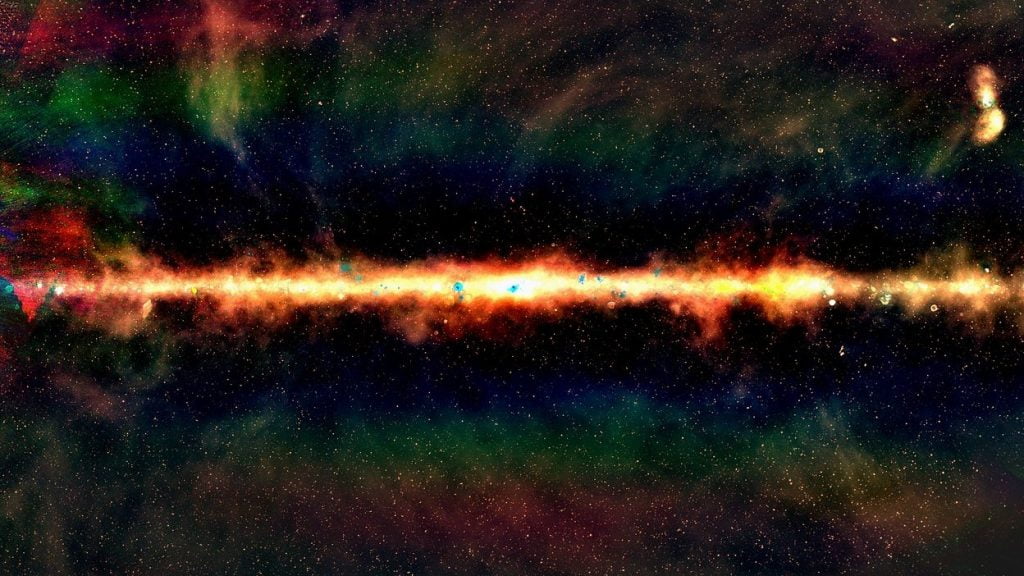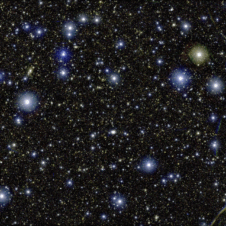A telescope located deep in the West Australian outback has shown what the Universe would look like if human eyes could see radio waves.
Published today in the Monthly Notices of the Royal Astronomical Society, the GaLactic and Extragalactic All-sky MWA, or ‘GLEAM’ survey, has produced a catalogue of 300,000 galaxies observed by the Murchison Widefield Array (MWA), a $50 million radio telescope located at a remote site northeast of Geraldton.
Lead author Dr Natasha Hurley-Walker, from Curtin University and the International Centre for Radio Astronomy Research (ICRAR), said this is the first radio survey to image the sky in such amazing technicolour.
“The human eye sees by comparing brightness in three different primary colours – red, green and blue,” Dr Hurley-Walker said.
“GLEAM does rather better than that, viewing the sky in 20 primary colours.
“That’s much better than we humans can manage, and it even beats the very best in the animal kingdom, the mantis shrimp, which can see 12 different primary colours,” she said.
GLEAM is a large-scale, high-resolution survey of the radio sky observed at frequencies from 70 to 230 MHz, observing radio waves that have been travelling through space—some for billions of years.
“Our team are using this survey to find out what happens when clusters of galaxies collide,” Dr Hurley-Walker said.
“We’re also able to see the remnants of explosions from the most ancient stars in our galaxy, and find the first and last gasps of supermassive black holes.”
MWA Director Associate Professor Randall Wayth, from Curtin University and ICRAR, said GLEAM is one of the biggest radio surveys of the sky ever assembled.
“The area surveyed is enormous,” he said. “Large sky surveys like this are extremely valuable to scientists and they’re used across many areas of astrophysics, often in ways the original researchers could never have imagined,” Associate Professor Wayth said.
Completing the GLEAM survey with the MWA is a big step on the path to SKA-low, the low frequency part of the international Square Kilometre Array (SKA) radio telescope to be built in Australia in the coming years.
“It’s a significant achievement for the MWA telescope and the team of researchers that have worked on the GLEAM survey,” Associate Professor Wayth said.
“The survey gives us a glimpse of the Universe that SKA-low will be probing once it’s built. By mapping the sky in this way we can help fine-tune the design for the SKA and prepare for even deeper observations into the distant Universe.”
PUBLICATION DETAILS
‘GaLactic and Extragalactic All-sky Murchison Widefi eld Array (GLEAM) survey I: A low-frequency extragalactic catalogue’, published in the Monthly Notices of the Royal Astronomical Society on October 27th, 2016.
Click here for the research paper
MORE INFORMATION
The MWA
The Murchison Widefield Array (MWA) is a low frequency radio telescope located at the Murchison Radio-astronomy Observatory in Western Australia’s Mid West. The MWA observes radio waves with frequencies between 70 and 320 MHz and was the first of the three Square Kilometre Array (SKA) precursors to be completed.
A consortium of 13 partner institutions from four countries (Australia, USA, India and New Zealand) has financed the development, construction, commissioning and operations of the facility. Since commencing operations in mid 2013 the consortium has grown to include new partners from Canada and Japan.
Key science for the MWA ranges from the search for redshifted HI signals from the Epoch of Reionisation to wide-field searches for transient and variable objects (including pulsars and Fast Radio Bursts), wide-field Galactic and extra-galactic surveys, and solar and heliospheric science.
The SKA
The Square Kilometre Array (SKA) project is an international effort to build the world’s largest radio telescope, led by SKA Organisation based at the Jodrell Bank Observatory near Manchester, England. Co-located primarily in South Africa and Western Australia, the SKA will be a collection of hundreds of thousands of radio antennas with a combined collecting area equivalent to approximately one million square metres, or one square kilometre. The SKA will conduct transformational science to improve our understanding of the Universe and the laws of fundamental physics, monitoring the sky in unprecedented detail and mapping it hundreds of times faster than any current facility.
ICRAR
The International Centre for Radio Astronomy Research (ICRAR) is a joint venture between Curtin University and The University of Western Australia with support and funding from the State Government of Western Australia.
CONTACT INFORMATION
Dr Natasha Hurley-Walker (Curtin University, ICRAR)
E: nhw@icrar.org
M: +61 426 192 677
Associate Professor Randall Wayth (Curtin University, ICRAR, CAASTRO)
E: randall.wayth@icrar.org
M: +61 418 282 359
Pete Wheeler, Media Contact, ICRAR
E: pete.wheeler@icrar.org
M: +61 423 982 018
Tamara Hunter, Media Contact, Curtin University
E: tamara.hunter@curtin.edu.au
M: +61 (08) 9266 3353
MULTIMEDIA
GLEAM-O-SCOPE
An interactive applet based on Chromoscope, that lets you explore our Galaxy (the Milky Way) and the distant Universe in a range of wavelengths from X-rays down to the GLEAM frequencies of 72-231 MHz.
Click here to open it in a new window and to embed this applet on another website, use the following code:
<iframe src="http://gleamoscope.icrar.org/gleamoscope/trunk/src/?w=2.2&l=355.5&b=-1&z=3" width="800" height="400"></iframe>
GLEAM Data Sphere Animation
A spherical view of the GLEAM survey, showing how it covers the entire southern sky. Red indicates the lowest frequencies, green the middle frequencies and blue the highest frequencies. Credit: Natasha Hurley-Walker (ICRAR/Curtin), Lister Staveley-Smith (ICRAR/UWA) and the GLEAM Team.
Image: The GLEAM Survey

The GLEAM view of the centre of the Milky Way, in radio colour. Red indicates the lowest frequencies, green indicates the middle frequencies and blue the highest frequencies. Each dot is a galaxy, with around 300,000 radio galaxies observed as part of the GLEAM survey. Credit: Natasha Hurley-Walker (Curtin / ICRAR) and the GLEAM Team.
The Electromagnetic Spectrum
A short video about radio waves and the electromagnetic spectrum presented by astrophysicist Dr Luke Davies from the International Centre for Radio Astronomy Research in Perth, Western Australia.

